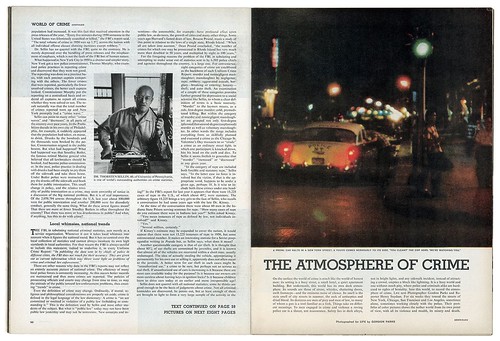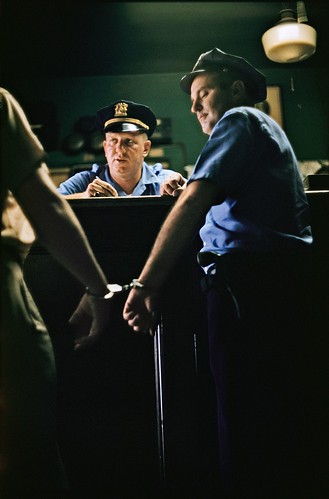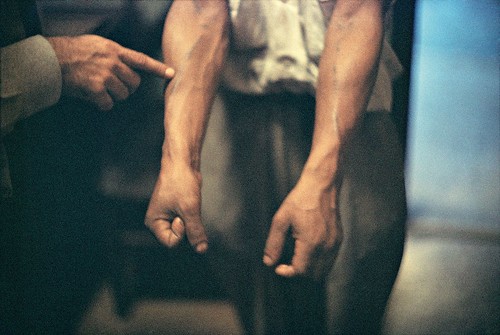Monday, 10:00am
22 June 2020
Netherworld of crime
A new book expands upon an impressionistic photo-essay about crime by Gordon Parks, including images not published at the time.
By Rick Poynor

Photo Critique by Rick Poynor, written exclusively for Eye magazine.
In September 1957, Life magazine began a series of articles devoted to crime in America and the first two pieces were designed to be complementary. After an attention-grabbing opening that gives details of recent murders, the introduction, ‘Crime in the U.S.’, settles into a tough-minded, statistical analysis of the so-called crime wave. The photographic essay that runs alongside, titled ‘The Atmosphere of Crime’, is far more impressionistic.
The visual essay’s co-author, Gordon Parks, had worked as a staff photographer for Life for almost a decade. He was the first African American to achieve this position following the publication of his photo-essay ‘Harlem Gang Leader’ in the magazine in November 1948. Parks’s achievements as a photographer opposed to racism, poverty and other social iniquities would have been more than enough to secure his reputation. He was also a writer and novelist, a film director (his credits include Shaft, 1971), a musician and composer.
The Atmosphere of Crime, 1957, co-published by The Gordon Parks Foundation and Steidl, is the latest in a series of books exploring Parks’s photographic legacy in detail. As with The Making of an Argument (2013) – about ‘Harlem Gang Leader’ – the article is reprinted in its entirety, close to full size, including the columns of editorial copy and advertising at the back. This allows us to assess the photographer’s achievement as a photojournalist within the original publishing context with a precision and understanding that was not possible in the days when only the pictures or a few low-quality images of the publication were reproduced in photography books.
‘The Atmosphere of Crime’, Life, 9 September 1957.
Top. Drug Search, Chicago, 1957. All photographs: Gordon Parks / The Gordon Parks Foundation.


Parks and a reporter, Henry Suydam, spent six weeks scouring the streets of New York, Chicago, San Francisco and Los Angeles. Sometimes they had police cooperation, at other times they went out alone. The eight-page feature has eleven colour pictures and another is used as a facing page for the introduction. The book shows a further 50 photographs, not published in Life, and a few more can be found on the foundation’s website.
Untitled, Chicago, 1957.

In the magazine, the emphasis dwells on atmosphere. The pictures, mostly shot at night or in gloomy interiors, are soft and grainy. The males under observation are mostly caught in long shot, often with their backs to us, their identities obscured. Only two detectives could be recognised from their picture; one of the partners, his gun raised and ready, kicks in an apartment door. The shot is a good example of the way pictures were cropped – here as a vertical slice – to fit the needs of the layout. The original picture shows expanses of dirty wall, with the drama taking place down the corridor. In this ‘netherworld’ of ‘violence and stealth … misery and death’ (the editor’s words) the act of crime is off-stage. The most violent scene Life’s readers got to see was the heavily bolted windows of a gas chamber awaiting use and the hearse that took away the executed murderer the following day.
Some of the unused pictures have the same melting ambience – figures on a street corner, an arm dangling a gun in a shard of orange light – but many are closer to the action and much harder hitting. A white cop struggles with a black man on a landing. A medic attends to a blood-soaked victim in the back of a filthy ambulance. We see the arms of an African-American in close-up as he injects himself with heroin; horribly scarred legs, most probably those of an abused youth, though age and gender are impossible to tell; and a body being pulled out of cold storage at the morgue. Handcuffs, fingerprinting, evidence for sifting and suspects for questioning – Parks delivered much more revealing pictures than Life’s editors chose to publish.
Morgue Photos of Dope Peddler Killed by Cops, Chicago, 1957.

The book arrives at a time when the racist brutality of American police forces has ignited national and international fury, and this makes Parks’s earlier insights, as an African-American observer, of even greater interest. Life’s introduction to the crime series notes that black people constituted 10 per cent of the population, but 30 per cent of the previous year’s arrests. In response to these alarming figures, a sociologist tells Life: ‘The responsibility lies where power, authority and discrimination has its source, the dominant white group.’
Police Raid, Chicago, 1957.

That was in 1957. Since the American government’s ‘war on drugs’ began in the 1970s, disproportionately impacting on poor black communities, the situation has grown much worse. Parks’s pictures are compassionate. The racial issue is present but it isn’t his sole concern and he sees crime in the round. In one untitled picture in Chicago, a black cop appears to examine the needle marks on a white addict’s arm. In another, the scene is reversed. Both black bodies and white bodies suffer in images that unflinchingly record whatever Parks finds in his sights.
Narcotics Addict, Chicago, 1957.

Rick Poynor, writer, Eye founder, Professor of Design and Visual Culture, University of Reading
Eye is the world’s most beautiful and collectable graphic design journal, published for professional designers, students and anyone interested in critical, informed writing about graphic design and visual culture. It is available from all good design bookshops and online at the Eye shop, where you can buy subscriptions and single issues.